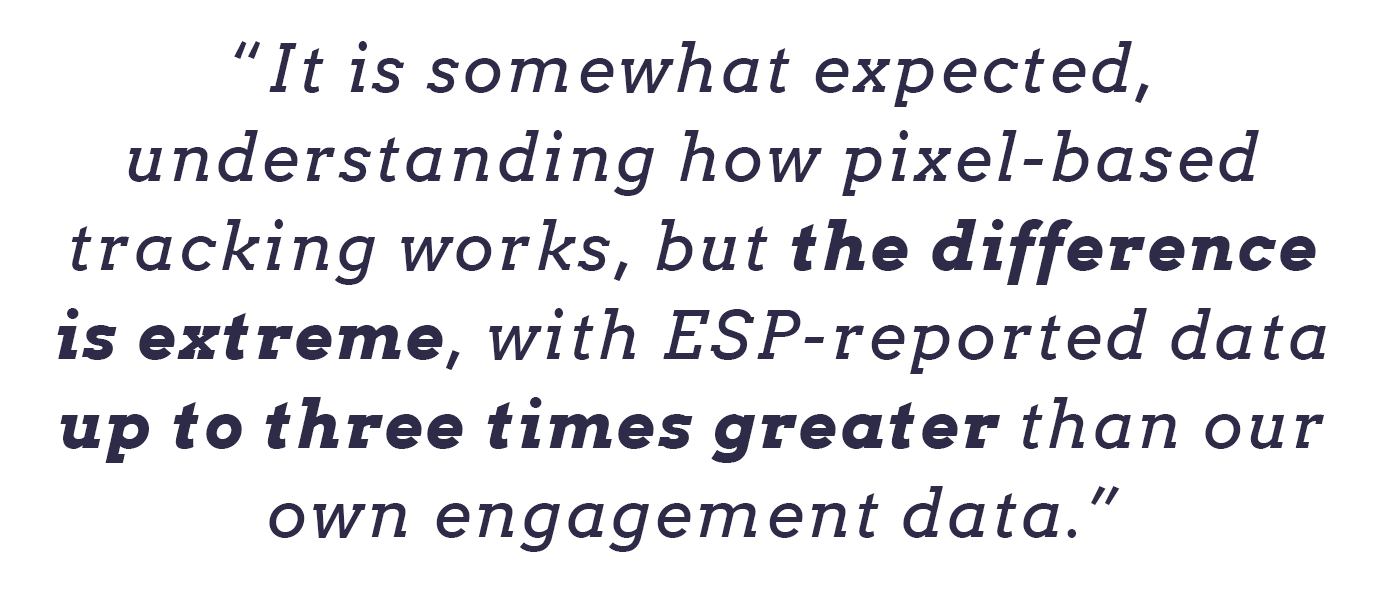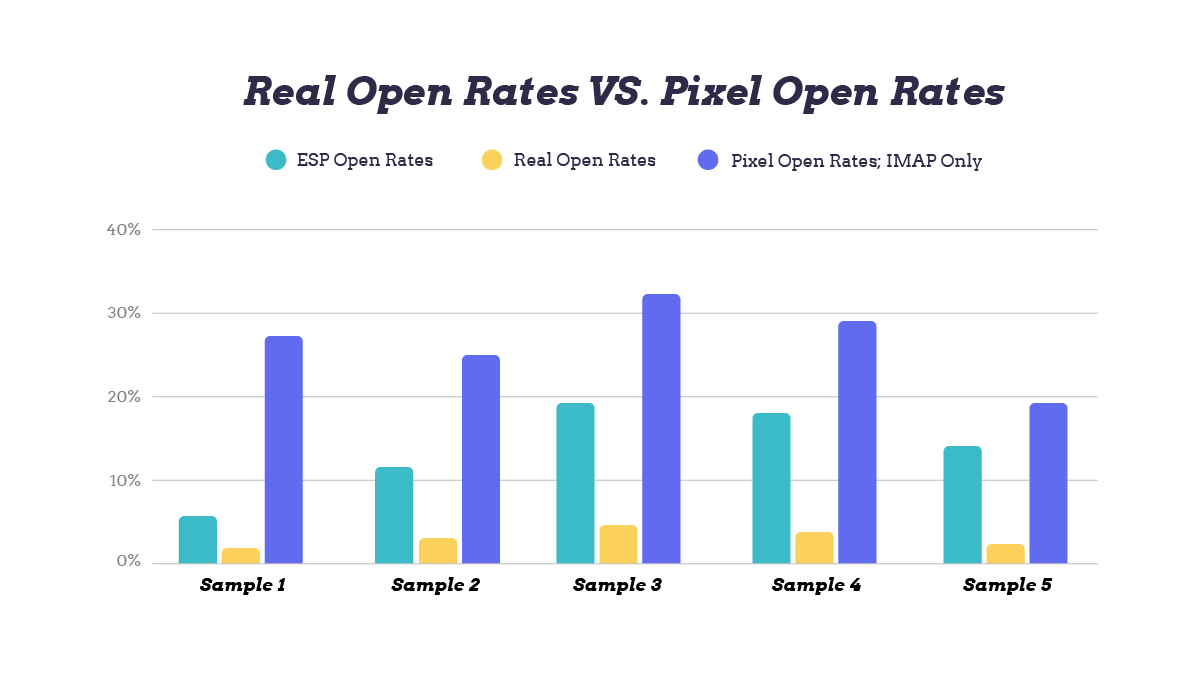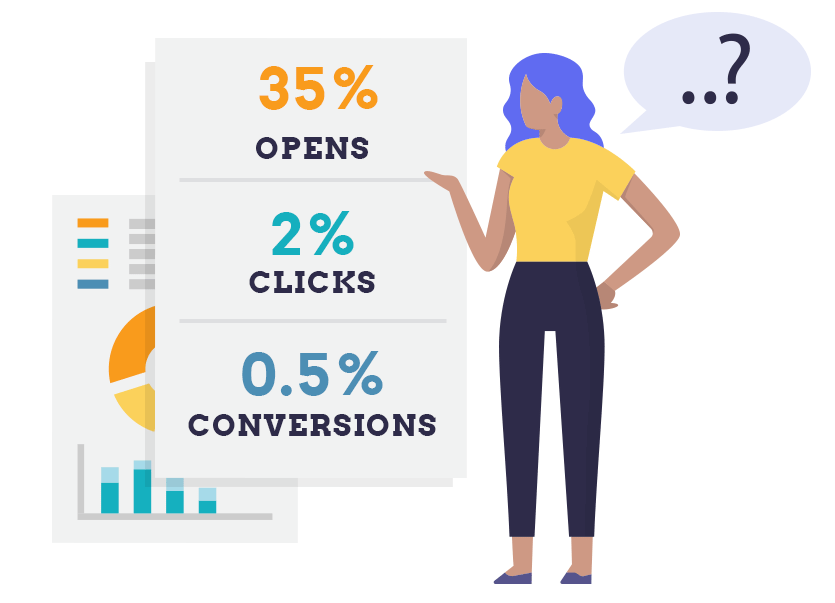
Open rates are a key engagement signal for marketers. I mean, the name says it all—it’s the rate at which your recipients are opening the email you send them. Who wouldn’t be invested in understanding how many emails are opened? For all intents and purposes, it’s an indicator of a great subject line, or a recipient well-targeted, or several other potential things marketers lean on as a KPI for success (or failure).
But at our Global Sender Summit, we heard some pretty startling information.
According to Yahoo (including AOL and Yahoo Mail), open rates provided by email service providers (ESPs) are dramatically inflated.
We need to dive a little deeper to give you the full impact. First, let’s look at how open rates are collected. Well, for the most basic data, a tracking pixel is embedded in the email code.
What is a pixel? It’s simply a small, transparent 1×1 pixel image. When the pixel is requested by a device, even if it isn’t fully rendered, it’s considered “open,” triggering a data point back to the sender.
But therein lies the potential problem: There are possibilities in which the pixel renders, but the email wasn’t truly opened by the recipient. Likewise, there are several situations in which the email could be opened, but not render the pixel.
“Since we control the email client, we can measure when emails are truly opened,” said Marcel Becker, director of product management at Yahoo. “When we look at that data, we see the open rate numbers on our side not matching the numbers typically reported by open tracking pixels.”
There are several factors potentially causing open rate inaccuracy. For instance, if someone has disabled downloading of email images, the pixel won’t render regardless of whether or not the email was opened. Thus, some true opens are not being considered in your rate. Even more interestingly, Yahoo found in their research mail clients using IMAP to fetch emails that are plugged into a charger and connected to Wi-Fi aggressively prefetch all content in an email, prompting nearly all open pixels to report as “opened.” Those emails could truly be deleted by the user without being opened, but since the pixel was prefetched (not even rendered, yet still considered “open”), your data tells you otherwise.
Additional reasons open rates could get wonky include images being enabled by default for various mail clients, mailbox providers caching images, and serving them via their own proxy servers, mail apps prefetching content to speed up rendering, anti-spam solutions crawling links and previewing URLs that trigger the pixel, and so on. With so many variables at play, it’s difficult to make a compelling case for structuring your email optimization decisions around open rates, rather than other more clear signals, like clicks and (of course) conversions.
What does this mean for marketers?
To be clear, this doesn’t mean all pixel-generated activity is inaccurate. It simply means marketers should be looking at the full picture of data they have at their disposal, such as trends in open rates.
Also, marketers really should be paying the most attention to activity truly signifying interest in your emails.
- Are your subscribers clicking on your call-to-action?
- Are they moving your email to spam?
- Are you seeing conversions to revenue from email campaigns?
These are concrete indicators of engagement speaking to the success of your email campaign.
Much like any marketer’s “stack,” a comprehensive approach doesn’t rely on one source. Treat your email analytics as the same. Open rates can be one crayon in your box, but it shouldn’t be the only thing coloring your picture.
For Validity users, this includes understanding how long recipients are spending engaging with your email—are they reading or simply skimming? Our pixel auto-detects and reports on image proxies, so quick read-time data (likely a false open) doesn’t muddy your results. Plus, since we can segment based on device, you can tailor your email design to the clients that matter most; when you determine which clients or devices give you the truest, highest engagement, you can start to pay attention to them more closely.
As an added benefit, Validity’s pixel is uniquely branded to you as well, meaning you aren’t subject to any shared tracking pixel reputation (in the event someone using the same pixel domain is a less-than-savory sender).



